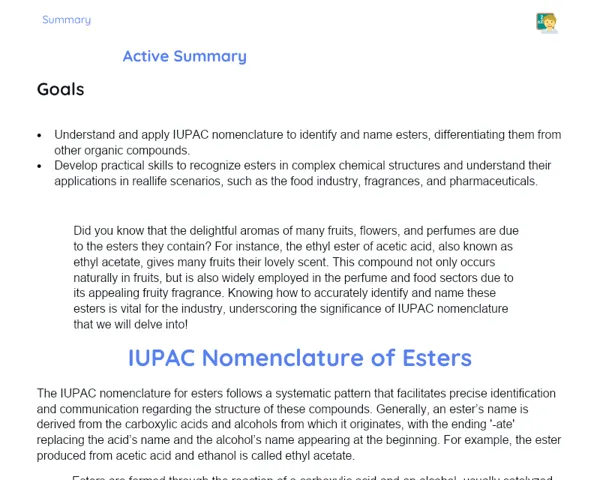Objectives
1. 🎯 Get well-versed with IUPAC nomenclature of amines, accurately identifying them amidst other organic compounds.
2. 🎯 Grasp the molecular structure of amines and put this knowledge to use through engaging hands-on activities.
Contextualization
Amines are not just important in the realm of chemistry; they also impact our daily lives significantly. These compounds are vital for creating essential items like life-saving medicines, cleaning agents, and cosmetics. For instance, methylamine plays a critical role in drug manufacturing but is not used for treating diabetes. This highlights the interconnection of chemistry with health and various industries, making the study of amines both meaningful and intriguing!
Important Topics
IUPAC Nomenclature of Amines
To understand amines, one must master their IUPAC nomenclature, which includes identifying the amine functional group (-NH2, -NHR, -NR2) alongside the primary carbon chain. Amines can be categorized as primary, secondary, or tertiary based on how many alkyl groups are attached to the nitrogen atom. This system provides a clear and standardized way of describing organic compounds.
-
Primary Amines: Have one alkyl or aryl group linked to nitrogen. Example: methylamine (CH3NH2).
-
Secondary Amines: Two alkyl or aryl groups are connected to nitrogen. Example: dimethylamine ((CH3)2NH).
-
Tertiary Amines: Three alkyl or aryl groups bond with nitrogen. Example: trimethylamine ((CH3)3N).
-
Importance of Correct Nomenclature: It aids effective scientific dialogue and research in the field of chemistry.
Molecular Structure of Amines
The defining characteristic of amines is the presence of a nitrogen atom that is bonded to alkyl or aryl groups. The unique electronic configuration of nitrogen in amines enables it to form bonds with other atoms or molecules, playing a vital role in their chemical and biological behavior, which includes aspects like solubility, basicity, and the ability to form hydrogen bonds.
-
Basicity of Amines: As Lewis bases, amines can accept protons because of the lone pair of electrons on nitrogen.
-
Solubility: Smaller amines tend to dissolve in water as they can establish hydrogen bonds with water molecules.
-
Biological Importance: Numerous amines function as neurotransmitters or hormones, such as adrenaline.
-
Industrial Applications: They're utilized in the production of polymers, dyes, and pharmaceuticals.
Practical Applications and Relevance of Amines
Apart from their foundational roles in biology and chemistry, amines feature prominently in numerous practical applications. They are instrumental in making medicines, cleaning products, cosmetics, and perfumes. By understanding their chemical traits and practical uses, we can appreciate the significance of amines in the study of organic chemistry.
-
Medication Production: Amines are integral components in various drugs, including antidepressants and pain relievers.
-
Perfumery: Amines play a role in the fragrance of many perfumes, interacting with other components to create rich scents.
-
Dye Production: They are crucial in dye manufacture, which is a cornerstone of the textile industry.
-
Connection to Everyday Life: The use of amines in cleaning supplies and cosmetics illustrates their relevance in our daily routines.
Key Terms
-
Amine: An organic compound that contains nitrogen, typically characterized by the presence of one or more alkyl or aryl groups attached to a nitrogen atom.
-
IUPAC Nomenclature: A standardized system used to name chemical compounds, ensuring precise and universal identification.
-
Functional Group: A group of atoms responsible for the distinctive chemical properties of a family of organic compounds.
For Reflection
-
In what ways can insights into the structure of amines contribute to the discovery of new medications?
-
How does the IUPAC nomenclature of amines enhance communication and collaboration among chemists across the globe?
-
What significance do amines hold in the perfume industry, and how does it influence the economy on a larger scale?
Important Conclusions
-
We recognize the pivotal role of amines in organic chemistry and their diverse applications, from pharmaceuticals to cosmetics.
-
We have become proficient in the IUPAC nomenclature of amines, an essential competency for effective communication and research in science.
-
We have examined the molecular structure of amines and how it affects their physical and chemical properties, crucial for various biological and industrial functions.
To Exercise Knowledge
Create an infographic that delineates the distinctions between primary, secondary, and tertiary amines. Include examples for each and show how their structures affect their properties and applications. Utilize drawings, diagrams, or design tools to make your infographic both visually engaging and educational.
Challenge
Chemical Detective Challenge: Imagine you are a scientist in a lab who has received five enigmatic samples. Your task is to figure out which of these samples contains amines and classify them as primary, secondary, or tertiary. Present your findings in an explanatory video, demonstrating how you applied your knowledge of nomenclature and structure of amines to achieve your results.
Study Tips
-
Regularly revisit the structural formulas of amines and practice IUPAC nomenclature using flashcards.
-
Watch videos on organic chemistry that illustrate practical experiments involving amines to better visualize their properties and reactions.
-
Engage in online chemistry forums or groups to discuss the practical uses of amines and resolve queries with fellow students and professionals.



